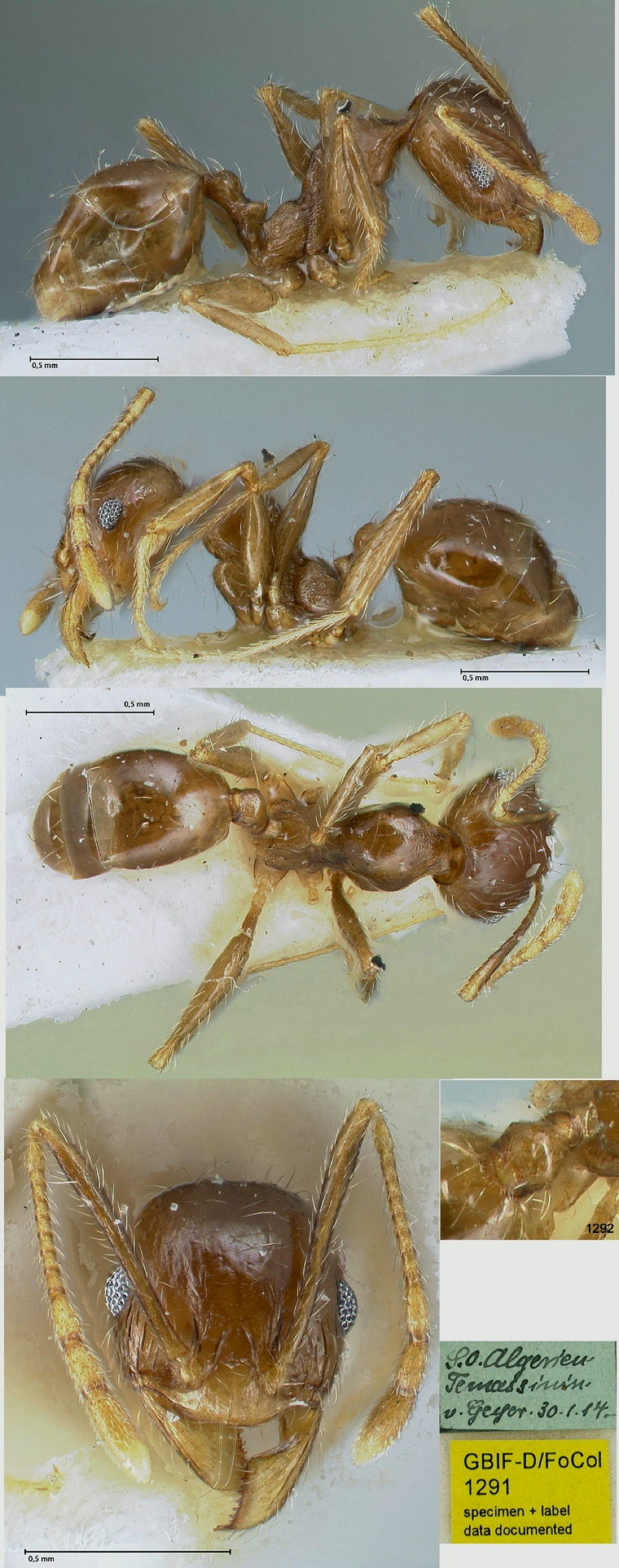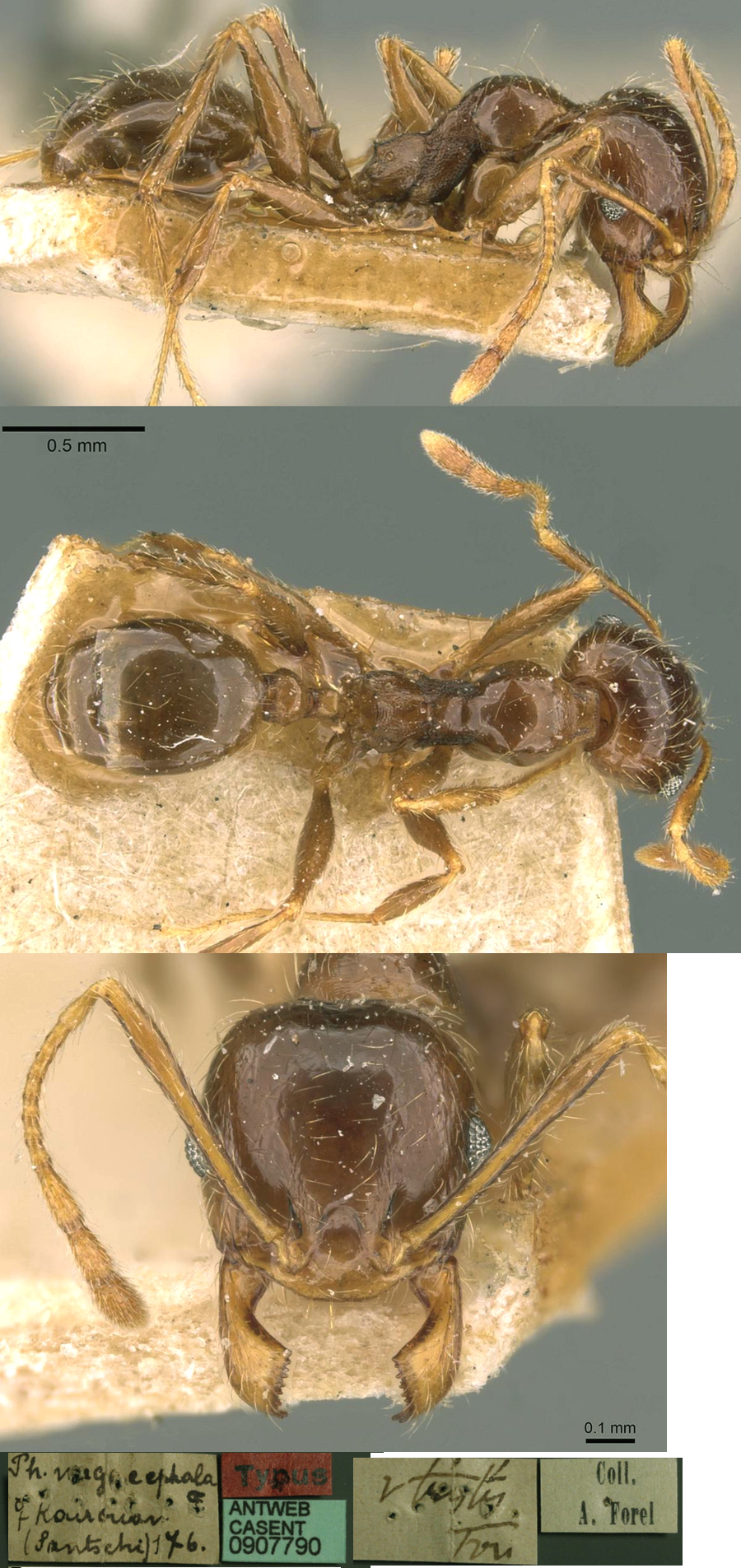|
 Photomontage
of the Pheidole pallidula
Nyl. v. cicatricosa n.v. minor worker from Algeria,
Temassini, 30.i.1914, collected by V Geyer; of Stitz (1917: 340). Photomontage
of the Pheidole pallidula
Nyl. v. cicatricosa n.v. minor worker from Algeria,
Temassini, 30.i.1914, collected by V Geyer; of Stitz (1917: 340).
Note: I have applied minor colour corrections to the
FoCol (slight reduction in brightness) and Antweb images (shift in
balance of magenta-green tone).
|
|
MINOR - TL ca 2.3 mm CI 87 SI 120 OI 28 PI 60
Egypt - El Minia
Head a short rectangle with the sides very weakly convex, posterior
angles broad and evenly rounded, the occiput straight; with a very
narrow nuchal collar
Mandibles moderately long, with a mixture of minute teeth and quite
coarse teeth on the masticatory margin; and two larger apical teeth
Anterior margin of clypeus quite strongly convex, without a median or
any other carinae; with only four forward facing, fine long hairs
Frontal carinae short and almost parallel; set quite far apart, about
0.4 X the width of the head at the level of the antennal insertions
Scapes long and slender, thickening very slightly from base to apex,
surpassing the occiput by about 1/4 of their length; funiculus about
33% longer than scape; the 3-segmented club has the apical segment as
long as the other two combined; the pre-apical segments are about twice
as long as they are wide
The eye is ovoid (12 facets long by 10 wide), quite large and strongly
convex; the anteriormost point is about 1.3 X own length back from the
anterior point of the genae
The pronotum from above is longitudinally ovoid and evenly convex at
the widest point; in profile, it is evenly and moderately convex with
the pro-mesonotal suture just visible and not interrupting the profile;
the metanotal groove is distinct and markedly impressed both dorsally
and laterally; the propodeum has the dorsum quite strongly convex in
profile and no lateral margination; the teeth are no more than very
minute sharp points; the declivity is slightly concave
The petiole has a fairly long pedicel and a moderately high triangular
profile, with the apex angular
The postpetiole has a low globular profile but is flat verntrally; from
above is only about 1.5 X as wide as the petiole, with the widest part
being at the midpoint of the rounded sides
The gaster is narrowly ovoid from above and globular laterally and from
above; it has a short, straight anterior margin
The legs are relatively short with weakly swollen femora
The whole of the head, body, antennae and legs bear quite fine, short,
semi-erect hairs
Shiny with very little sculpturation other than very fine longitudinal
striations on the lateral head
Overall quite dark red-brown with lighter appendages and pedicel;
speculatively the minors of cicatricosa have lost much of their
colour since collected in 1914.
|
 Photomontage of a minor
worker collected in Spain, Garden Costa i Llobera, Barcelona,
by Xavier Espadaler. The location is a dry cactus garden and Xavier
commented (in litt) - "it seemed to me they were too big for P.
pallidula". Photomontage of a minor
worker collected in Spain, Garden Costa i Llobera, Barcelona,
by Xavier Espadaler. The location is a dry cactus garden and Xavier
commented (in litt) - "it seemed to me they were too big for P.
pallidula".
|
 Main species page
Main species page Photomontage
of the Pheidole pallidula
Nyl. v. cicatricosa n.v. minor worker from Algeria,
Temassini, 30.i.1914, collected by V Geyer; of Stitz (1917: 340).
Photomontage
of the Pheidole pallidula
Nyl. v. cicatricosa n.v. minor worker from Algeria,
Temassini, 30.i.1914, collected by V Geyer; of Stitz (1917: 340). The photomontage of
the
The photomontage of
the  The photomontage of
the
The photomontage of
the  The
photomontage is of a minor from Egypt, El-Minia, 2008,
collected by Mahmoud Fadl Ali.
The
photomontage is of a minor from Egypt, El-Minia, 2008,
collected by Mahmoud Fadl Ali.  Photomontage of a minor
worker collected in Spain, Garden Costa i Llobera, Barcelona,
by Xavier Espadaler. The location is a dry cactus garden and Xavier
commented (in litt) - "it seemed to me they were too big for P.
pallidula".
Photomontage of a minor
worker collected in Spain, Garden Costa i Llobera, Barcelona,
by Xavier Espadaler. The location is a dry cactus garden and Xavier
commented (in litt) - "it seemed to me they were too big for P.
pallidula". Photomontage of a minor
worker collected in Mali, Bamako, 12.37.18 N 008.00.27 W; by
David M King (King 43).
Photomontage of a minor
worker collected in Mali, Bamako, 12.37.18 N 008.00.27 W; by
David M King (King 43).